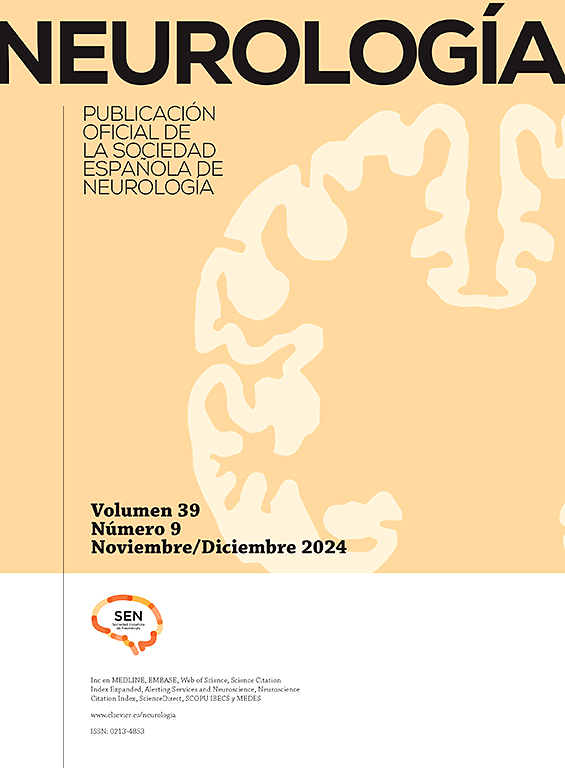Composición del trombo e implicaciones en la caracterización y el tratamiento en el ictus isquémico
IF 3.1
4区 医学
Q2 CLINICAL NEUROLOGY
引用次数: 0
Abstract
Introduction
Since mechanical thrombectomy has allowed ischemic stroke thrombi retrieval, its exhaustive study has involved a better knowledge of physiopathological processes implied in its formation.
Development
Thrombotic pathways involved in the different vascular beds shared common mechanisms conditioning difficulties in the identification of specific patterns associated with stroke etiology. Other factors as clot formation time, associated inflammatory status or activation of additional immune and coagulation pathways (Neutrophil extracellular traps [NETs] delivery, platelet aggregation, endothelial activation and Von Willebrand Factor release) have been described as determinants in thrombus characteristics. In consequence, variable proportions of fibrin/platelet-rich and erythrocyte-rich areas coexist among the thrombus with a close relation within them, accompanied frequently by a protective outer shell with high concentrations of fibrin, NETs and Von Willebrand Factor. The presence of these components, as well as its distribution and interrelationships have demonstrated to have effect on thrombus resistance to revascularization treatments. An adequate knowledge of this pathways has allowed to develop adjuvant therapies capable of enhance current fibrinolytic drugs and/or increase efficacy of endovascular treatments.
Conclusion
The knowledge of thrombus components and mechanisms involved in its formation open a potential way in ischemic stroke therapeutics with promising perspectives.
血栓成分及其对缺血性中风的特征描述和治疗的影响
由于机械取栓已经允许缺血性卒中血栓回收,其详尽的研究已经涉及到在其形成隐含的生理病理过程的更好的知识。不同血管床中涉及的血栓形成途径具有共同的机制,在确定与卒中病因学相关的特定模式方面存在困难。其他因素如血栓形成时间、相关炎症状态或其他免疫和凝血途径的激活(中性粒细胞细胞外陷阱[NETs]递送、血小板聚集、内皮活化和血管性血友病因子释放)被认为是血栓特征的决定因素。因此,不同比例的富含纤维蛋白/血小板的区域和富含红细胞的区域在血栓中共存,并在它们内部有着密切的关系,经常伴随着含有高浓度纤维蛋白、NETs和血管性血友病因子的保护性外壳。这些成分的存在,以及它们的分布和相互关系已被证明对血栓对血运重建治疗的抵抗有影响。对这一途径的充分了解使得开发辅助疗法能够增强当前的纤溶药物和/或提高血管内治疗的疗效。结论对血栓组成及其形成机制的认识为缺血性脑卒中的治疗开辟了一条有前景的新途径。
本文章由计算机程序翻译,如有差异,请以英文原文为准。
求助全文
约1分钟内获得全文
求助全文
来源期刊

Neurologia
医学-临床神经学
CiteScore
5.90
自引率
2.60%
发文量
135
审稿时长
48 days
期刊介绍:
Neurología es la revista oficial de la Sociedad Española de Neurología y publica, desde 1986 contribuciones científicas en el campo de la neurología clínica y experimental. Los contenidos de Neurología abarcan desde la neuroepidemiología, la clínica neurológica, la gestión y asistencia neurológica y la terapéutica, a la investigación básica en neurociencias aplicada a la neurología. Las áreas temáticas de la revistas incluyen la neurologia infantil, la neuropsicología, la neurorehabilitación y la neurogeriatría. Los artículos publicados en Neurología siguen un proceso de revisión por doble ciego a fin de que los trabajos sean seleccionados atendiendo a su calidad, originalidad e interés y así estén sometidos a un proceso de mejora. El formato de artículos incluye Editoriales, Originales, Revisiones y Cartas al Editor, Neurología es el vehículo de información científica de reconocida calidad en profesionales interesados en la neurología que utilizan el español, como demuestra su inclusión en los más prestigiosos y selectivos índices bibliográficos del mundo.
 求助内容:
求助内容: 应助结果提醒方式:
应助结果提醒方式:


